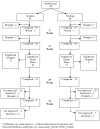Patching vs atropine to treat amblyopia in children aged 7 to 12 years: a randomized trial
- PMID: 19064841
- PMCID: PMC2846774
- DOI: 10.1001/archophthalmol.2008.107
Patching vs atropine to treat amblyopia in children aged 7 to 12 years: a randomized trial
Abstract
Objective: To compare patching with atropine eyedrops in the treatment of moderate amblyopia (visual acuity, 20/40-20/100) in children aged 7 to 12 years.
Methods: In a randomized, multicenter clinical trial, 193 children with amblyopia were assigned to receive weekend atropine or patching of the sound eye 2 hours per day. Main Outcome Measure Masked assessment of visual acuity in the amblyopic eye using the electronic Early Treatment Diabetic Retinopathy Study testing protocol at 17 weeks.
Results: At 17 weeks, visual acuity had improved from baseline by an average of 7.6 letters in the atropine group and 8.6 letters in the patching group. The mean difference between groups (patching - atropine) adjusted for baseline acuity was 1.2 letters (ends of complementary 1-sided 95% confidence intervals for noninferiority, -0.7, 3.1 letters). This difference met the prespecified definition for equivalence (confidence interval <5 letters). Visual acuity in the amblyopic eye was 20/25 or better in 15 participants in the atropine group (17%) and 20 in the patching group (24%; difference, 7%; 95% confidence interval, -3% to 17%).
Conclusions: Treatment with atropine or patching led to similar degrees of improvement among 7- to 12-year-olds with moderate amblyopia. About 1 in 5 achieved visual acuity of 20/25 or better in the amblyopic eye.
Clinical relevance: Atropine and patching achieve similar results among older children with unilateral amblyopia.
Trial registration: (clinicaltrials.gov) Identifier: NCT00315328.
Figures
References
-
- Pediatric Eye Disease Investigator Group Randomized trial of treatment of amblyopia in children aged 7 to 17 years. Arch Ophthalmol. 2005;123:437–47. - PubMed
-
- Beck RW, Moke PS, Turpin AH, et al. A computerized method of visual acuity testing: adaptation of the early treatment of diabetic retinopathy study testing protocol. Am J Ophthalmol. 2003;135:194–205. - PubMed
-
- Moke PS, Turpin AH, Beck RW, et al. Computerized method of visual acuity testing: adaptation of the amblyopia treatment study visual acuity testing protocol. Am J Ophthalmol. 2001;132:903–9. - PubMed
-
- Cole SR, Beck RW, Moke PS, et al. The amblyopia treatment index. J AAPOS. 2001;5:250–4. - PubMed
-
- Pediatric Eye Disease Investigator Group A randomized trial of atropine regimens for treatment of moderate amblyopia in children. Ophthalmology. 2004;111:2076–85. - PubMed
Publication types
MeSH terms
Substances
Associated data
Grants and funding
LinkOut - more resources
Full Text Sources
Medical
Miscellaneous



